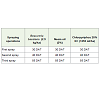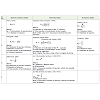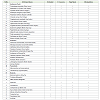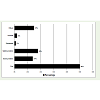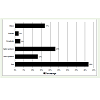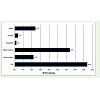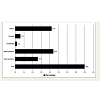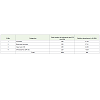Research Article
Effects of Botanicals, Myco-Insecticide and Organophosphorous Insecticidal Spray on Biodiversity of Rice Field Arthropods
Devarassou K1*, Ardra S Raghunath2, Huny George3, Reshma M4, Saranya S Pillai5, Archana US6
1Department of Agricultural Entomology, Pandit Jawaharlal Nehru College of Agriculture & Research Institute,Karaikal -609 603, Union Territory of Pondicherry, India
2-62Department of Agricultural Entomology, Adhiparasakthi Agricultural College (APAC), G.B. Nagar, Kalavai - 632 506, Vellore district, Tamil Nadu, India
Corresponding author: Devarassou K, Department of Agricultural Entomology, Pandit Jawaharlal NehruCollege of Agriculture & Research Institute, Karaikal -609 603, Union Territory of Pondicherry, India; E-mail: kdevarasu@gmail.com
Citation: Devarassou K, Raghunath AS, George H, Reshma M, Pillai SS, et al.Effects of Botanicals, Myco-Insecticide and Organophosphorous Insecticidal Spray on Biodiversity of Rice Field Arthropods. J Plant Sci Res. 2016;3(1): 152.
Copyright © Devarassou K 2016, et al. This is an open access article distributed under the Creative Commons Attribution License, which permits unrestricted use, distribution, and reproduction in any medium, provided the original work is properly cited.
Journal of Plant Science & Research | ISSN: 2349-2805 | Volume: 3, Issue: 1
Submission: 08/06/2016; Accepted: 24/06/2016; Published: 01/07/2016
Abstract
Field experiments were conducted at APAC farm, Kalavai during samba season (Nov 2012-Jan 2013) to study the effect of insecticidal spray namely Chlorpyriphos 20% EC (Organophosphorus), Beauveria bassiana (Entomopathogen fungus), Vijay Neem (Botanical) on the biodiversity of rice field arthropods. Exactly 2000 m2 (0.5 ac) was taken for each insecticidal spray area. Totally four 0.5 ac fields were adopted for this studies including one unsprayed condition for comparison. The present study was under taken with special reference to collection and identification of insect and spider species; relative abundance of pest, insect predators, parasitoids, neutrals, spider predators and other category; computation of species richness, diversity and evenness indices on the treated rice fields. The study indicated that in Kalavai region, 16 taxa of pests, 10 taxa of insect predators, two taxa of parasitoids and neutrals, eight taxa of other insect categories and one category of spider were observed during the entire season. Considering the sum of all the insects fauna (pests, insect predators, parasitoids, neutrals) and spider predators, relative abundance under Untreated, B. bassiana; Vijay Neem; and Chlorpyriphos 20% EC treated fields were 31.02 %, 27.91%, 22.80% and 18.26% respectively. It was observed that total relative abundance was highest in unsprayedcondition followed by B. bassiana and vijay neem treated fields.
Keywords: Beauveria bassiana; Vijay neem; Chlorpyriphos; Arthropods; Biodiversity; Rice; Relative abundance; Species richness index and Shannon-Weaver index
Introduction
Synthetic insecticides are often considered a quick, easy, and inexpensive solution for controlling insect pests in agriculture.Tremendous benefits have been derived from the use of syntheticinsecticides in agriculture. The food grain production of India,which stood at a mere 50 million tonnes in 1948-49, had increasedalmost fourfold to 198 million tonnes by the end of 1996-97 from an estimated 169 million ha of permanently cropped land. This resulthas been achieved by the use of high yield varieties of seeds, advancedirrigation technologies and agricultural chemicals like insecticides(Employment Information: Indian Labour Statistics, 1994) [1].However, insecticides have contaminated almost every part of ourenvironment. Insecticide residues are found in soil, air, and in surfaceand ground water. Insecticides contamination poses significant risks to the environment and non-target organisms ranging frombeneficial soil microorganisms to insects, plants, fish and birds.Ideally, an insecticide must be lethal to the targeted pests, but not tonon-target species, including man. Unfortunately, this is not, so thecontroversy of use and abuse of pesticides has surfaced. The rampantuse of these chemicals, under the adage, “if little is good, a lot morewill be better†has played havoc with human and other life forms.Indiscriminate use of chemical pesticide adversely affects the naturalbiodiversity that resulted in the reduction of natural enemies [2]. Thebest way to reduce insecticide contamination in our environmentis for all of us to do our part to use safer and approach towardsnon-chemical pest control methods. Under non-chemical controlmeasures, bioinsecticides like Nuclear Polyhedrosis Virus, Bacillusthuringiensis, Beauveria bassiana, plays major roles, which are saferwith respects to non-residual nature in farm products unlike thesynthetic insecticides. However, the non-chemical biopesticdes likeBeauveria bassiana (mycoinsecticide fungus) and plant originatedchemical based botanicals like neem formulations need to be verifiedfor their effects on the natural enemies and the insect biodiversity, sinceboth of them are broad spectrum insecticides. With this perspectivea study was conducted to verify the effects of mycoinsecticide(Beauveria bassiana), botanicals and synthetic OP insecticides on thebiodiversity of rice field arthropods at Adhiparasakthi AgriculturalCollege, Kalavai, Vellore district, Tamil Nadu (India). A tropicalrice field offers a biologically diverse and dynamic environment formicrobial, floral and invertebrate population to flourish shortly afterthe fields are flooded and continuing well after canopy closure [3,4].Arthropod inventories can be good indicators of habitat biodiversitybecause arthropods respond quickly to environmental changes, sincethey are highly diverse in nature [5]. Because of their diversity, insectsprovide the opportunity to detect smaller, more inconspicuouschanges in ecosystems that might otherwise go undetected byfocusing only on larger, more conspicuous vertebrate species [6]. Inrice, natural bio control has a potential role to play in management ofrice insect pests [7]. The present study reports the influence of variousinsecticides namely (i) Synthetic organophosphorous insecticides (Chlorpyriphos 20% EC), (ii) mycoinsecticide (Beauveria bassiana)and (iii) Botanicals (Vijay neem oil 2%) on the biodiversity of ricefield arthropods.
Materials and Methods
The present study investigated the effects of synthetic OP, botanicaland myco insecticides on the biodiversity of rice field arthropods. Thestudy investigated documentation and identification of arthropodfauna; computation of relative abundance, species richness anddiversity indices; on the sprayed and unsprayed conditions.
Experimental details: Field trials were conducted during sambaseason of 2012-2013 in the ‘I’ block of Adhiparasakthi AgriculturalCollege, Kalavai, Vellore district, Tamil Nadu (India). Exactly 2000m2 (0.5 ac) was taken for each insecticidal spray area. Totally four0.5 ac fields were adopted for this studies including one unsprayedcondition for comparison. Hence, the trial comprised of four fieldsviz., synthetic, botanical, microbial and untreated conditions. Ricevariety raised was ADT 43. Random method of planting was adoptedin each field. Other recommended agronomic practices were carriedout regularly on the four field conditions.
Insecticidal spray details: Spraying of Beauveria bassiana(Balsamo) Vuillemin at the rate of 2.5 kg/ha (Obtained frombiocontrol lab KVK, Pondicherry, India), neem oil 2% (vijay neem,vijay agrochemicals, Chennai, India) and chlorpyriphos 20% EC atthe rate of 1250 ml/ha each at 30, 40 and 55 days after transplanting(DAT) was made using high volume backpack knapsack sprayer(Table 1). Spraying operations on different field conditions were carried out during evening hours between 4:00 to 6:00 pm.
Method of sampling insect and spider species
Main field: Visual sampling method was adopted with a hill asa sampling unit. Week wise samples of insect and spider species on25 hills per field were taken at random for measurement of relativeabundance [8], species richness, diversity and evenness index [9].
Collection and identification of insects and spider species: Ineach treatment the insect and spider fauna were collected on weeklybasis during morning hours (6-8 am). The insect and spider specieswere collected using aspirators, sweep nets, and hand picks. Collectedinsects and spiders were sorted out based on taxon. Soft bodiedinsects and spider species were preserved on 85% ethyl alcohol inglass vials. Other insects were card mounted and pinned. The mostcommon and important insect and spider fauna were identified to thelowest possible taxon, usually families or genus or species.
Relative abundance
Relative abundance was measured by the formula,
R= a/N X 100 [8]
Where,
R= Relative abundance
a = Total population of a particular species or taxon.
N= Total population of all the species or taxon.
Note: Relative abundance measures the percentage of individualsover all the species.
Biodiversity indices: In order to assess the biodiversity ofarthropods on the rice fields which are treated with differentinsecticides, various ecological indices have been utilized. Completecount of organisms is not practicable and hence indirect solutionwas adopted for practical purpose to measure the biodiversity ofa community. In the present study, three species richness, fourdiversity and two evenness indices were utilized for measurementof biodiversity on (1) Synthetic organophosphorous insecticides (Chlorpyriphos 20% EC), (2) Mycoinsecticide (Beauveria bassiana)and (3) Botanical insecticide (Vijay neem-2%) treated conditions(Table 2).
Table 2: Biodiversity indices utilized to assess the rice field arthropod diversity under various sprayed condition.
Statistical analysis: Biodiversity indices have been calculatedusing the software qbasic. The week wise biodiversity indices havebeen calculated and mean values were analyzed using Analysis ofvariance (ANOVA) on SPSS statistical software.
Results
Documentation of arthropod fauna
During the entire crop period of different sprayed and unsprayed conditions, 16 taxa of herbivorous insects (pest), 10 taxa of insect predators, two taxa each in parasitoids and neutrals, eight taxa of other categories and one taxon of spider categories were observed(Table 3).
Table 3: Arthropod fauna documented on the rice fields during samba season (2012-13) on B. bassiana, Vijay Neem, Chlorpyriphos and untreated condition.
Relative abundance
The relative abundance of pest (herbivore), insect predators, spiderpredators, parasitoids, neutral arthropods and other insect categoriesfor the entire Samba season has been computed on unsprayed andvarious insecticidal sprayed conditions. The result revealed that therelative abundance (RA) of pest category on unsprayed, B. bassiana, vijay neem and chlorpyriphos sprayed conditions were 50%, 42%,42% and 40% respectively (Graph 1, Graph 2, Graph 3, Graph 4), indicating chlorpyriphos sprayed rice field documented leastherbivorous taxa. It is also inferred that relative abundance of pestcategories was highest on unsprayed rice field condition, which isfollowed by B. bassiana and vijay neem sprayed conditions. However,considering the sum of all the insect fauna (pests, insect predators,parasitoids, neutrals) and spider predators, relative abundance ofuntreated, B. bassiana, vijay neem and chlorpyriphos treated fieldswere 31.02 %, 27.91%, 22.80% and 18.26% respectively, indicatingrelative abundance of total arthropod biodiversity was highest underunsprayed condition which is followed by B. bassiana and vijay neemtreated fields (Table 4). The least arthropod abundance (RA) was recorded under chlorpyriphos sprayed rice field conditions.
Graph 1: Total relative abundance of rice field arthropods under untreated, B. bassiana, vijay neem and chlorpyriphos treated conditions.
Graph 2: Total relative abundance of rice field arthropods under untreated, B. bassiana, vijay neem and chlorpyriphos treated conditions.
Graph 3: Total relative abundance of rice field arthropods under untreated, B. bassiana, vijay neem and chlorpyriphos treated conditions.
Graph 4: Total relative abundance of rice field arthropods under untreated, B. bassiana, vijay neem and chlorpyriphos treated conditions.
Table 4: Total relative abundance of rice field arthropods under untreated, B. bassiana, vijay neem and chlorpyriphos treated conditions.
Species richness index
The number of all species (N0) is the unambiguous and straightforward index of species richness, where the total number of speciesin a community can be calculated regardless of their abundance. Themean value of Species richness index (N0) during the entire cropperiod of samba season were 9.82 ± 0.56, 9.82 ± 0.86, 8.36 ± 0.83 and7.55 ± 0.65 for untreated, B. bassiana, vijay neem and chlorpyriphostreated condition respectively, which are not significantly different, indicating number of taxa in all the sprayed and unsparyed conditionswere similar (Table 5).
Table 5: Mean value of ecological indices (species richness, diversity and evenness index) on untreated, B. bassiana, vijay neem oil and chlorpyriphos treated conditions.
The species richness index R1 (Margalef) [10], includes totalnumber of individuals taxa along with their abundance. The meanindex values of R1 during the entire crop period of samba season were2.53 ± 0.15, 2.54 ± 0.31, 2.33 ± 0.27 and 2.15 ± 0.16 for untreated,B. bassiana, vijay neem and chlorpyriphos treated conditionrespectively, which are not significantly different, indicating all the differently sprayed and one unsprayed rice field conditions followssimilar type of species richness (Table 5).
The species richness index R2 (Mehinick) [11], is another typeof index similar to Margalef index, also consider the total numberof species along with their abundance. According to this index, themean value of R2 during the samba season were 1.72 ± 0.11, 1.73± 0.23, 1.71 ± 0.18 and 1.66 ± 0.09 for untreated, B. bassiana, vijayneem and chlorpyriphos sprayed fields, which were not significantlydifferent, indicating all the sprayed and unsprayed conditions follows indicating number of taxa in all the sprayed and unsparyed conditionswere similar (Table 5).
The species richness index R1 (Margalef) [10], includes totalnumber of individuals taxa along with their abundance. The meanindex values of R1 during the entire crop period of samba season were2.53 ± 0.15, 2.54 ± 0.31, 2.33 ± 0.27 and 2.15 ± 0.16 for untreated,B. bassiana, vijay neem and chlorpyriphos treated conditionrespectively, which are not significantly different, indicating all the differently sprayed and one unsprayed rice field conditions followssimilar type of species richness (Table 5).
The species richness index R2 (Mehinick) [11], is another typeof index similar to Margalef index, also consider the total numberof species along with their abundance. According to this index, themean value of R2 during the samba season were 1.72 ± 0.11, 1.73± 0.23, 1.71 ± 0.18 and 1.66 ± 0.09 for untreated, B. bassiana, vijayneem and chlorpyriphos sprayed fields, which were not significantlydifferent, indicating all the sprayed and unsprayed conditions follows indicating number of taxa in all the sprayed and unsparyed conditionswere similar (Table 5).
The species richness index R1 (Margalef) [10], includes totalnumber of individuals taxa along with their abundance. The meanindex values of R1 during the entire crop period of samba season were2.53 ± 0.15, 2.54 ± 0.31, 2.33 ± 0.27 and 2.15 ± 0.16 for untreated,B. bassiana, vijay neem and chlorpyriphos treated conditionrespectively, which are not significantly different, indicating all the differently sprayed and one unsprayed rice field conditions followssimilar type of species richness (Table 5).
The species richness index R2 (Mehinick) [11], is another typeof index similar to Margalef index, also consider the total numberof species along with their abundance. According to this index, themean value of R2 during the samba season were 1.72 ± 0.11, 1.73± 0.23, 1.71 ± 0.18 and 1.66 ± 0.09 for untreated, B. bassiana, vijayneem and chlorpyriphos sprayed fields, which were not significantlydifferent, indicating all the sprayed and unsprayed conditions follows indicating number of taxa in all the sprayed and unsparyed conditionswere similar (Table 5).
The species richness index R1 (Margalef) [10], includes total number of individuals taxa along with their abundance. The mean index values of R1 during the entire crop period of samba season were 2.53 ± 0.15, 2.54 ± 0.31, 2.33 ± 0.27 and 2.15 ± 0.16 for untreated,B. bassiana, vijay neem and chlorpyriphos treated conditionrespectively, which are not significantly different, indicating all the differently sprayed and one unsprayed rice field conditions followssimilar type of species richness (Table 5).
The species richness index R2 (Mehinick) [11], is another typeof index similar to Margalef index, also consider the total numberof species along with their abundance. According to this index, themean value of R2 during the samba season were 1.72 ± 0.11, 1.73± 0.23, 1.71 ± 0.18 and 1.66 ± 0.09 for untreated, B. bassiana, vijayneem and chlorpyriphos sprayed fields, which were not significantlydifferent, indicating all the sprayed and unsprayed conditions follows similar species richness (Table 5).
Diversity Index
The diversity indices incorporate both species richness andevenness into a single value. Shannon index (H’) is the most popularand widely used index in community ecology. It is the averagedegree of ‘uncertainity’ and if this average ‘uncertainity’ increases, the number of species increases and then distribution of individualsamong the species also become even. The mean value of Shannonindex (H’) for the entire samba season were 1.84 ± 0.08, 1.94 ± 0.11,1.69 ± 0.12 and 1.64 ± 0.08 for untreated, B. bassiana, vijay neemand chlorpyriphos sprayed condition respectively, which were notsignificantly different, saying differently sprayed and unsprayed ricefields follows similar arthropod diversity (Table 5).
The Simpson index of diversity (λ) is another familiar typeof ecological index, which are used to assess the biodiversity of anecosystem. Simpson index value varies from 0 to 1 and if the valuetends towards zero it indicates higher diversity; (i.e) the probabilityof individuals drawn at random from a population will not belong tothe same species, meaning diversifications. The mean index value (λ)for the entire crop period during samba season were 0.21 ± 0.03, 0.28± 0.09, 0.25 ± 0.05 and 0.21 ± 0.04 for untreated, B. bassiana, vijayneem and chlorpyriphos treated condition respectively, which arenot significantly different, indicating unsprayed and different sprayedrice fields follows similar trend of arthropod diversity (Table 5).
Hills diversity number N1 and N2 are called effective numberof taxa present in a sample and their unit is number of species. N1is the number of ‘equally less abundant species’; and N2 is numberof ‘equally very abundant species’. The less abundant species (N1)may be parasitoids, neutrals or a pollinator in rice fields. These lessabundant species in the rice fields plays a major role in maintenanceof a balance in the ecosystem, as they are serving as a check for thebuildup of herbivore population as in the case of parasitoids or mayserve as a food for predators as in the case of neutrals species. Thesignificance of very abundant species (N2) is that, mostly they belongto herbivorous with one or two species of predator populations withrespect to rice fields.
The mean index value of ‘equally less abundant species’ (N1)during entire crop period were 6.33 ± 0.51, 7.26 ± 0.70, 5.90 ± 0.76 and5.33 ± 0.39 for untreated, B. bassiana, vijay neem and chlorpyriphossprayed condition respectively which were not significantly differentat 5% level, indicating all the differently sprayed and an unsprayedrice field follows similar trend of less abundant species (Table 5).
The mean index value of ‘equally very abundant species’ (N2) forthe entire crop period during samba season were 6.05 ± 1.09, 7.42± 0.99, 6.40 ± 1.31 and 5.08 ± 0.49 for untreated, B. bassiana, vijayneem and chlorpyriphos treated condition respectively, which werenot significantly different, indicating all the three different sprayedand an unsprayed rice fields follows similar trend of ‘equally veryabundant species’ (Table 5).
Evenness index
The evenness index E1 value for the entire crop period duringsamba season were 0.80 ± 0.03, 0.86 ± 0.07, 0.78 ± 0.04 and 0.83± 0.03 for unsprayed, B. bassiana, vijay neem and chlorpyriphossprayed rice fields respectively, indicating the evenness of arthropodsdistribution over the rice field remain similar for all the treated anduntreated conditions.
The mean value of evenness index E2 for the total crop periodduring samba season were 0.64 ± 0.06, 0.74 ± 0.03, 0.70 ± 0.04 and 0.72 ± 0.03 for unsprayed, B. bassiana, vijay neem and chlorpyriphossprayed conditions respectively, indicating evenly distribution of ricefield arthropods for all treated and untreated conditions.
Discussion
Documentation of arthropod fauna
The documented arthropods seem to be almost similar in differentsprayed (synthetic, botanical, mycoinsecticide) and unsprayedcondition (Table 3). This finding was in confirmatory with that ofDevarassou and Adiroubance [12,13], who reported that similar kindof arthropod fauna were documented on Integrated pest managementadopted and non-adopted rice field conditions, where non-adoptedrice field condition was sprayed with two organophosphorousinsecticides namely chlorpyriphos 20% EC at the rate of 1250 ml/haand monocrotophos 36 SL at the rate of 625ml/ha.
Relative abundance
The result furnishes, among the three insecticidal sprayconditions, the chlorpyriphos treated condition suppresses the pestcategory effectively. Whereas, B. bassiana and vijay neem sprayedconditions were equally effective in controlling the rice pest, butfollows next to chlorpyriphos treated conditions. This finding wasin confirmatory with that of Radha et al. [14,15] who reported thatchlorpyriphos proved to be highly effective against aphid pest ofcowpea as compared to that of spinosad and neem seed kernel extract.
From the result, it is also inferred that the total relative abundance which considered, all the arthropod fauna irrespective of categories indicated that unsprayed rice field follows highest RA, which is followed by B. bassiana and vijay neem sprayed conditions. The leastRA was followed under chlorpyriphos treated condition (Table 4).These findings were in agreement with those of Hassan and Rashid [9]who reported that, in the University Pertanian Malaysia (UPM), wherepesticides had never been sprayed, recorded higher number of totalarthropod taxa when compared to Tanjung Karang (TK) and BukitCawi (BC) of Malaysia. The result also inferred that, biopesticide andbotanical insecticide sprayed field recorded highest arthropod faunaover synthetic chlorpyriphos treated conditions. This finding was inconfirmatory with that of Adiroubance and Devarassou [12], who reported that the relative abundance of Integrated Pest Management (IPM) adopted rice field conditions have recorded highest percent of arthropod fauna, where biopesticide namely Bacillus thuringeinsis and neem coated urea was applied.
Species richness Index
The mean value of species richness indices N0, R1, R2 duringthe entire crop period of samba season were not significantlydifferent for B. bassiana, vijay neem, chlorpyriphos and unsprayedrice field. This finding was in agreement with those of Devarassouand Adiroubane [12], who reported that IPM adopted rice field had maintained better species richness, which was sprayed withbiopesticide Bacillus thuringeinsis as well as applied with neemcoated urea, indicating application of biopesticides like B. bassianaand neem oil on rice fields shall be safer to non-target organism andalso maintain stable arthropod population in the rice field. Also,application of chlorpyriphos being a synthetic OP compounds, on rice fields did not reduced the arthropod diversity considerably,indicating organophosphorus group of insecticides are safer torice field arthropods. This may be due to less persistent natureof OP compounds. This finding was in confirmatory with that ofMichelle Fountain, [16] who reported applications of soil insecticide chlorpyriphos on grassland had increased the species richness, diversity and evenness of soil collembolan Ceratophysella denticulate, but had reduced the spider population drastically.
Hence, from the result it is concluded that application of mycoinsecticde, botanicals and synthetic OP compounds did not reducethe species richness of arthropods in the rice fields considerably.These results clearly indicated, the concept of complete eradicationor local extinction of arthropods cannot be possible by application ofabove mentioned insecticides. Hence, application of B. bassiana, vijayneem and chlorpyriphos on rice fields, though make some impact onthe non-target arthropods fauna like predators, parasitoids, neutralsand pollinators immediately after insecticidal applications, but hadregained its populations and abundance later. This might be due todiverse nature of rice field arthropods.
Diversity index
Shannon index (H’) and Simpson index (λ) of diversity forthe entire rice crop period during samba season were not differentsignificantly [17,18], indicating similar trend of arthropod diversitywas maintained for chlorpyriphos, vijay neem and B. bassiana sprayedand one unsprayed field conditions. Similar results were reportedby Devarassou and Adiroubance [12], where IPM adopted fieldconditions had higher arthropod diversity over Non-IPM adoptedcondition, in which IPM adopted rice fields were treated with neemcoated urea, B. thuringiensis and synthetic insecticide carbofuron 3G(during nursery). The results confirm that application of biopesticideand synthetic insecticides in rice ecosystem would not affect thearthropod diversity permanently. If affected, it would be temporarytill the toxicity of insecticide remains in the fields. Since, all the three insecticide namely chlorpyriphos, B. bassiana and vijay neem takenfor the study are less-persistent, re-colonization’s of arthropods hadoccurred few days after application. This principle of re-colonization’scould be attributed to higher reproductive potential, different modeof life stages, smaller size and diverse nature of rice field arthropods.
The number of ‘equally less abundant taxa’ (N1) for the entirecrop period during samba season was not different significantly,implying unsprayed and all the sprayed rice field conditions namelyB. bassiana, vijay neem and chlorpyriphos had maintained similartrend. ‘Equally less abundant taxa’ are the most important componentin the rice field which is significant in maintaining the balance ofoverall diversity. The range of N1 fluctuate between 5.33 to 7.26 onunsprayed and differently sprayed rice field conditions, indicating the5 to 7 species are equally less abundant.
The numbers of ‘equally very abundant taxa’ (N2) for the entirecrop period during samba season were not significantly different,indicating untreated and treated conditions had followed similartrend. The value of N2 decides the overall diversity of the rice fields.From the results it is inferred that the value of N2 ranges from 5.08to 7.42, implying about 5-7 species are equally very abundant during the entire trail period. From the result it is also inferred that the valueof ‘equally less abundant species’ (N1) and ‘equally very abundantspecies’ (N2) remain same (5-7 taxa), indicating about 10-14arthropod taxa were dominating the entire rice fields irrespective ofinsecticidal sprayings. This was in agreement with Heong and Aquinowho reported that the arthropod diversity was determined by 6-9 taxaof arthropods in the rice fields of IRRI farm, Phillipines [19-21].
The results revealed that the mean value of various speciesrichness index (No, R1, R2) and diversity index (λ, H’, N1 and N2)under different insecticide treated and an untreated condition ofrice field remain same. This has indicated that due to applications ofvarious insecticides like botanical, myco-insecticide and synthetic OPcompounds under irrigated rice field, the diversity of arthropods wasnot reduced considerably. Hence, in order to conclude, the differentinsecticide taken for the study seems to be safer with respect tomaintenance of arthropod biodiversity. It can also be concluded thatapplications of three sprayings of insecticides by myco-insecticide(B. bassiana), botanicals (vijay neem) and synthetic OP compound(chlorpyriphos), did not make any critical effects on the biodiversityof rice field arthropods.
Evenness index
The results furnished that the evenness indices E1 and E2 for theentire rice growing period of samba season seems to be maintainingsimilar trend for all the sprayed and an unsprayed condition. Thiswas in agreement with that of Devarassou and Adiroubane, [12]who reported that under IPM adopted rice field conditions, theevenness was in a higher trend, where the field was treated withneem coated urea and biopesticide namely B. thuringiensis. However,chlorpyriphos being a synthetic insecticide also show similar trend ofarthropod evenness like botanicals and mycoinsecticide. This mightbe due to less persistent nature of OP compounds.
Conclusion
The result inferred that, three sprayings each from synthetic OP insecticides, myco-insecticide and botanicals did not reduces the ricefield arthropods, indicating the concept of eradication of arthropodsis not at all possible. After each insecticidal spray, the arthropodpopulation were reduced, but had rebuilt similar type of populationafter few days, which depends upon the persistence of insecticidecompounds. Hence, application of mycoinsecticide, botanical andsynthetic organophosphorous insecticide did not pose a seriousthreat to biodiversity of rice field arthropods.
References
- Employment Information: Indian Labour Statistics (1994) Chandigarh: Labour Bureau, Ministry of Labour, 1996.
- 2.Ranga Rao GV, Rameshwar Rao V, Reddy YVR, Murthy KSRK (2005) Status of safety in pesticide use in Asia: Option for improvement. In: proceeding of the National Seminar on Pesticide Residues and their Risk Assessment organized by Food and Drug Toxicology Research Centre, National Institute of Nutrition, Hyderabad, January 20-21, 2005: 129-136.
- Schoenly KG, Justo HD, Barrion AT, Harris MK, Bottrell GD (1998) Analysis of invertebrate biodiversity in Philippines farmers irrigated rice field. Envrion Entomol 27: 1125-1136.
- Settle WH, Ariawan H, Triastute E, Cahyana W, Hakim AL, et al. (1996) Managing tropical rice pests through conservation of generalist natural enemies. Ecology 77: 1975-1988.
- Longino JF (1994) Project ALAS (arthropod of la selva) summary. May. Estacion Biologist La Selva Costa Rica, Central America.
- Danks HV (1996) How to assess insect biodiversity without wasting your time. Document Series No. 5, Biological Survey of Canada (Terrestrial Arthropods), Ottawa. 20 pp.
- Way MJ, Heong KL (1994) The role of biodiversity in the dynamics and management of insect pests of tropical irrigated rice- a review. Bull Entomol Res 84: 567-587.
- Singh NN, Rai S (2000) Relative abundance of different Coccinellids in Mustard ecosystem. Indian J Ent 62: 422-426.
- Hassan STS, Rashid MM, Arshad MA (1995) Sampling of paddy field arthropods. In: Proceedings of IRPA Seminar of the Faculty of Science and Environment Studies, Universiti Pertanian Malayasia, Serdang, 20-21 June 1995.
- Margalef R (1958) Information theory in ecology. General Systematics 3: 36-71.
- Margalef R (1958) Information theory in ecology. General Systematics 3: 36-71.
- Devarassou K, Adiroubance D (2006) Arthropod biodiversity in integrated pest management adopted tropical rice ecosystem. In: proceedings of the National symposium on Biodiversity and Insect Pest Management. Organized by Entomology Research Institute, Loyola College, Chennai, February 3 - 4, 2005: 93-103.
- Adiroubane D, Devarassou K (2006) Relative abundance of arthropod fauna in tropical rice ecosystem in Karaikal region. In: proceedings of the National symposium on Biodiversity and Insect Pest Management. Organized by Entomology Research Institute, Loyola College, Chennai, February - 4, 2005: 71-79.
- Radha R (2013) Comparitive studies on the effectiveness of pesticides for aphid control in cowpea. Res J Agriculture and Forestry Sci 1: 1-7.
- Fountain MT, Brown VK, Gange AC, Symondson WOC, Murray PJ (2001) The effects of the insecticide chlorpyrifos on spider and Collembola communities. Pedobiologia 51: 147-158.
- Shannon CE, Wiener W (1949) The mathematical theory of communication. University Illinois Press, Urban.
- Simpson EH (1949) Measurement of diversity. Nature 163: 688.
- Heong KL, Aquino GB (1990) Arthropod diversity in tropical rice ecosystem. IRRI 15: 31-32.
- Hill MO (1973) Diversity and evenness: A unifying notation and its consequences. Ecology 54: 427-432.
- Sheldon AL (1969) Equitability indices: dependence on the species count. Ecology 50: 466-467.
- Pielou EC (1977) Mathematical Ecology, Wiley, New York.

